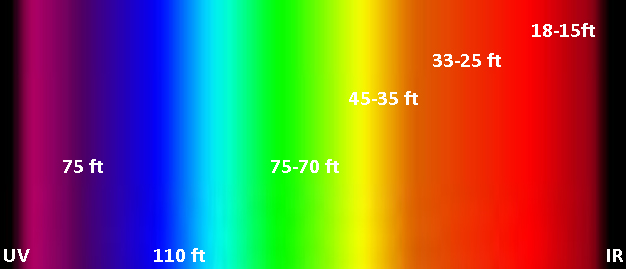As an addendum to the previous post, I’ve gone through a number or sources for the various depths at which the various colors will no longer be discernible underwater. For most freshwater rivers and lakes color loss underwater will be at approximately:
- Red ~15-18 ft (5 m) (note: after 5 m ~ 90% of the intensity of red is gone)
- Orange ~ 25-33 ft (10 m)
- Yellow ~ 35-45 ft (10-14m)
- Green ~ 70-75 ft (20 m)
- Blue ~ 110 ft (30-33 m)
- Purple ~ 75 ft (20 m)
These numbers are for clear water only, depths will be shallower with the introduction of particulate matter, organic materials, tea stain etc.
A special note on Fluorescent Colors
An object that is fluorescent emits light of a longer wavelength after absorbing light of a shorter wavelength. Thus, a fluorescent lure that appears chartreuse/yellow in color is absorbing light in the green-blue-ultraviolet portion of the spectrum – i.e. colors that are available at greater depths! This is why fluorescent colors can be seen at greater depths than normal. Fluorescent colors also work particularly well on cloudy days, when the visible light spectrum is diminished but UV light (short wavelength) is still quite strong.




so – how does white, black, silver and gold fit into the picture? What does a white jig head look like at 40ft? at 75ft?
As colors of the spectrum are lost as one goes deeper in the water column, contrast and flash will become more important. Black, which reflects no light, will still be black and will be best seen against a lighter background – for example a sandy bottom. White will reflect all remaining light at a particular depth. So if red, orange and yellow are filtered out at ~ 40 ft in clearwater, the white still reflects what is left – my guess is it would be looking gray/green/blueish. We also have to remember that at this depth, the overall light available has diminished greatly (i.e. it’s getting dark). So color, though visible, may be less important than contrast here. White’s contrast to a dark rocky or mud bottom will be more important. We must also remember that what our human eyes see may be different than what a particular species of fish will see (walleye being an important exception – see previous post).
For metallics like gold and silver, the flash of the reflected remaining light is what is attracting the fish, even if certain colors have been filtered out. So in the dark blue underwater world of a lake trout at 70 ft – a flash of brighter blueish tinged light coming off a silver lure still mimics the flash coming off a shiny cisco.
On a side note: Red hooks will be black (no red light left to reflect) after 15-18 ft (less in tea stained waters).